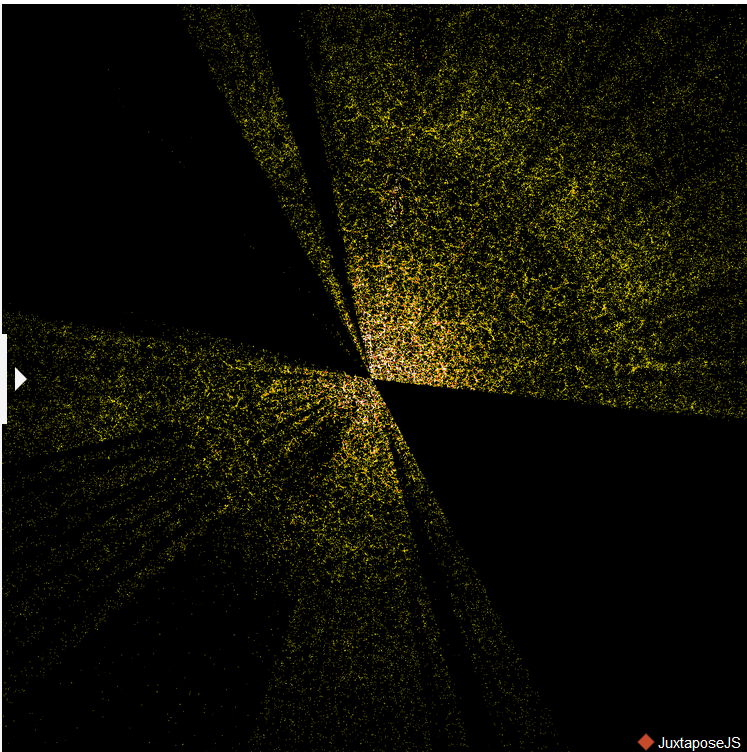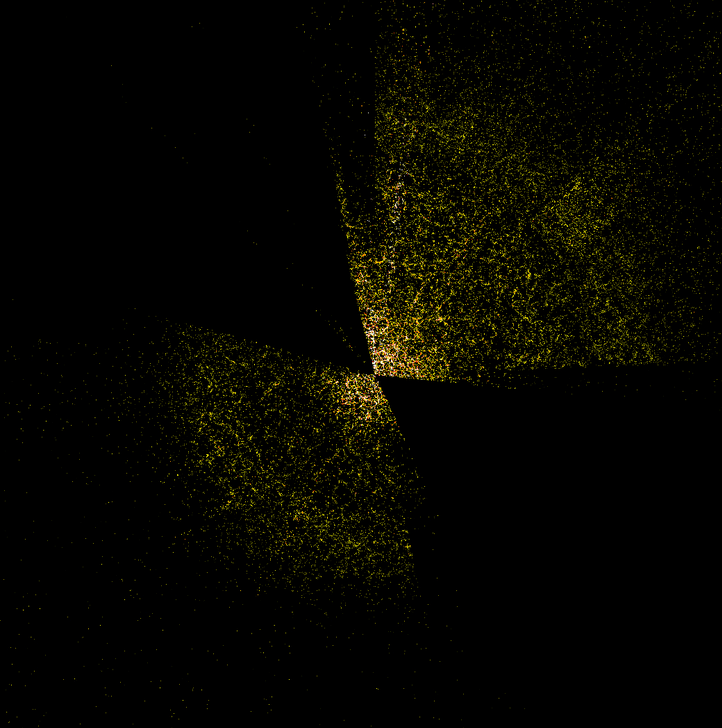K-State Physics Researchers Contribute to Dark Energy Spectroscopic Instrument’s Map of the Cosmos
The Dark Energy Spectroscopic Instrument (DESI), celebrated a significant milestone this month in its galaxy survey. DESI is an international science collaboration managed by the Department of Energy’s Lawrence Berkeley National Laboratory with primary funding for construction and operations from DOE’s Office of Science. The experiment measured accurate positions of more than 7,500,000 distant galaxies in its first seven months of operation. This exceeds the number of galaxy positions measured by all previous experiments combined. The achievement is even more impressive considering that DESI is just 10% of the way through its planned five-year mission. By the end of its run in 2026, DESI is expected to have over 35 million galaxies in its catalog, enabling an enormous variety of cosmology and astrophysics research.
The photo below (left) shows one slice of a three-dimensional map of the galaxies observed so far by DESI. The earth is at the center, and the furthest galaxies are more than 10 billion light-years away. The empty slices pointing towards the upper-left and lower-right of the photo are parts of the sky where the DESI telescope did not look. They are covered by our Galaxy disks that block the light, making it very difficult to observe distant objects.
For comparison, the photo on the right shows a similar map, which was the biggest map prior to DESI using data collected by the Sloan Digital Sky Survey.

|

|
A K-State research group in Physics, led by associate professor Lado Samushia, has been working on making and analyzing these DESI maps. Samushia has been involved with DESI since the project was proposed. He is currently co-leading a working group of international collaborators conducting research to find statistical patterns in the distribution of the observed galaxies in space.
These patterns can be used to study properties of Dark Energy and Dark Matter – components that make up 95% of the Universe, although we do not yet know much about their fundamental physical nature. They can also be used to measure very important properties of our Universe, such as its expansion rate and the amount of spatial curvature.
Graduate research assistant Hanyu Zhang has been involved in the DESI experiment since 2018. He is helping the DESI team understand the properties of observed galaxies and to quantify the errors in the measurements. Hanyu’s research paper based on early DESI data is now undergoing an internal collaboration review and will be submitted to a peer-reviewed journal later this month.
Hanyu is working on three other papers based on his DESI work that will be published later in 2022. “I am very excited to be working on one of the biggest astrophysics experiments. I hope I will be able to continue contributing to this international effort after I graduate from K-State”, said Hanyu.
DESI uses the Nicholas U. Mayall 4-meter telescope at Kitt Peak National Observatory near Tucson, Arizona to collect its data. The observatory is a program of the National Science Foundation’s NOIRLab, which the Department of Energy contracts with to operate the Mayall Telescope for the DESI survey. The DESI collaboration is honored to be permitted to conduct scientific research on Iolkam Du’ag (Kitt Peak), a mountain with particular significance to the Tohono O’odham Nation.
The telescope experiment was proposed more than a decade ago. Construction began in 2015 and was the telescope was ready to collect data at the end of 2019 but was delayed due to the Coronavirus pandemic. In May 2021 DESI was finally able to begin its data collection.
DESI is supported by the DOE Office of Science and by the National Energy Research Scientific Computing Center, a DOE Office of Science user facility. Additional support for DESI is provided by the U.S. National Science Foundation, the Science and Technologies Facilities Council of the United Kingdom, the Gordon and Betty Moore Foundation, the Heising-Simons Foundation, the French Alternative Energies and Atomic Energy Commission (CEA), the National Council of Science and Technology of Mexico, the Ministry of Economy of Spain, and by the DESI member institutions.